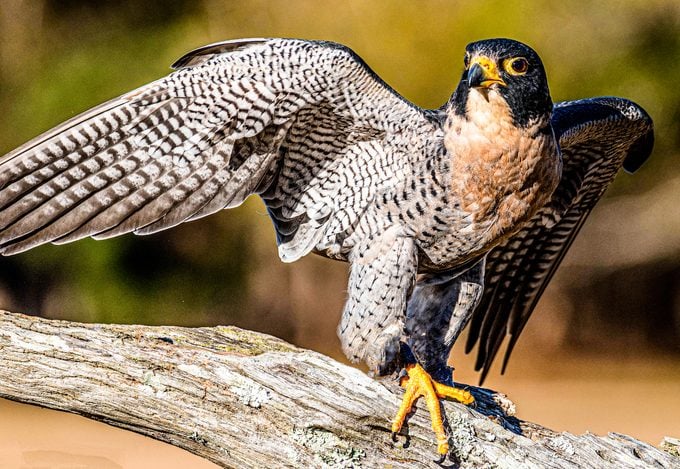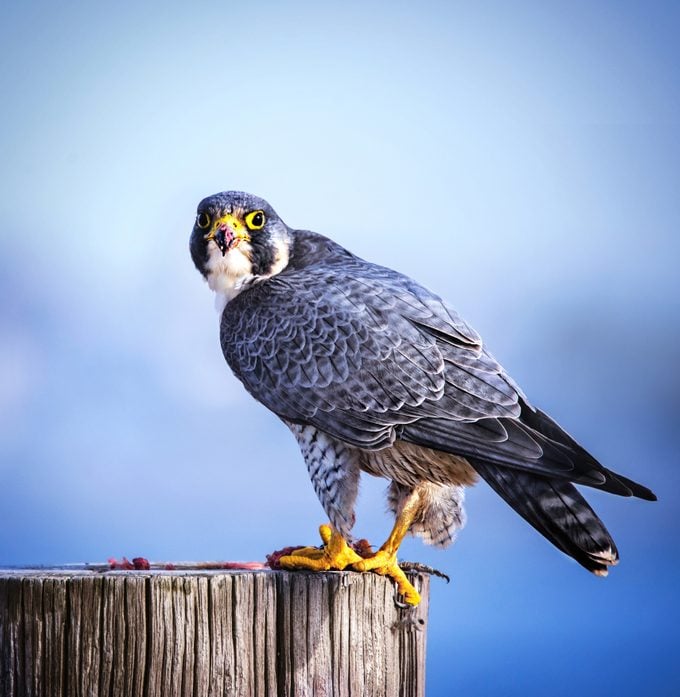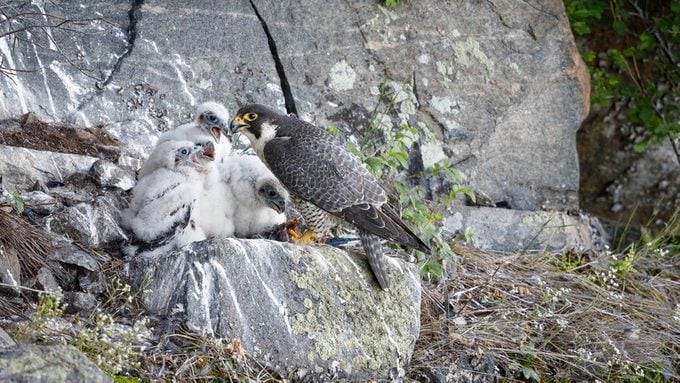The Peregrine Falcon Is the World’s Fastest Animal
Updated: Jul. 10, 2024
Faster than a speeding bullet? Maybe not. But the peregrine falcon can top 200 miles mph when it dives, beating every other animal on the planet.
On This Page
How Fast Is a Peregrine Falcon?

Ask people to name the fastest animal on earth, and they’ll likely guess it’s the cheetah. It’s true the cheetah can outrun any land animal at speeds up to 80 mph, but the peregrine falcon (Falco peregrinus) has it beat by a long shot. Find out just how fast these raptors are, and learn more about this amazing bird of prey.
Learn more amazing falcon facts every birder should know.

In ordinary flight, this raptor averages more than 30 mph (48 kph), and when it’s pursuing prey on the level, it can hit nearly 70 mph (112 kph). That’s impressive, but on its own that’s not enough to hold the record for fastest animal on the planet.
Peregrine falcons zoom past the competition during their spectacular hunting dives, known as stoops. A bird soars high into the atmosphere, as much as .62 miles (1 km) above the earth. Then it turns and plunges straight down, folding its wings to create the perfect aerodynamic shape.
At the peak velocity of its dive, this raptor can reach and surpass speeds of 200 mph (320 kph). That’s about the same as the average NASCAR racer’s top speed!
Meet more of the fastest birds in North America.
Peregrine Falcon Identification

This member of the falcon family is about the size of a crow. Its body measures 14 to 19 inches long, with a wingspan between 39 and 43 inches. Males and females look alike (though males are smaller), slate-colored blue gray above with barred white underparts.
Juveniles are more heavily streaked underneath, with bars extending all the way to the head and along the tail, while mature adults have a white breast patch just beneath their chins.
The American kestrel is the smallest falcon.
Call and Sound
Birds sounds courtesy of the Cornell Lab of Ornithology
When they’re alarmed, peregrine falcons give a harsh “kak-kak-kak” call. Otherwise, these birds are very quiet, as befits a master hunter.
Do hawk sightings have special meaning?
Habitat and Range
Birders who want to catch a glimpse of this impressive raptor are in luck, because it can be found on every continent except Antartica. Peregrine falcons are migratory, so even if they don’t breed or winter in your area, there’s a chance of spotting one during its seasonal travels. In fact, the name “peregrine” means “wanderer,” which is exactly what they do.
In North America, they breed in the very far north, down through the Rocky Mountains into Mexico. They also nest and live year-round in cliffside areas along the West and East Coast and the Appalachians, and in a few scattered areas in the midwest. During the winter, migratory peregrine falcons follow the coasts south, with many spending the cooler months in the Gulf Coast, Caribbean or Mexico.
Discover 9 types of hawks you should know.
What Does a Peregrine Falcon Eat?
These birds of prey mostly dine on other birds, which they often snatch right out of the sky during their astonishing hunting stoops. They’ve been spotted attacking avians of all sizes, from hummingbirds to sandhill cranes. They also love to snack on bats.
Peregrine Falcon Nesting Habits

As cliff dwellers, peregrine falcons usually nest on ledges from 25 to 1,300 feet off the ground. Suitable nesting habitat has dwindled over the years, so some of these raptors have moved into cities, nesting on window ledges instead. They occasionally use nesting boxes on tall buildings.
These falcons generally mate for life, returning to the same nesting location each year. The male scrapes out a shallow nest, and together they care for 3 to 4 eggs, which are creamy to reddish-brown, heavily marked with brown spots, and a little smaller than a pool ball.
The female does most of the incubating and stays with the newly-hatched young, while the male hunts and brings food for them all. As the chicks grow, both male and female head out to hunt to feed their rapacious brood. Chicks fledge in about 40 days.
Don’t miss these simply stunning pictures of hawks.
Are Peregrine Falcons Endangered?
While peregrine falcon numbers are reasonably strong and stable today, that wasn’t the case during the DDT crisis of the 1950s-70s. In fact, the eastern population was extirpated entirely, and they were nearly wiped out in the west, too. Fortunately, this impressive species rebounded after the DDT ban, and it was removed from the Endangered Species list in 1999.
Next, learn how to identify a merlin falcon.




















